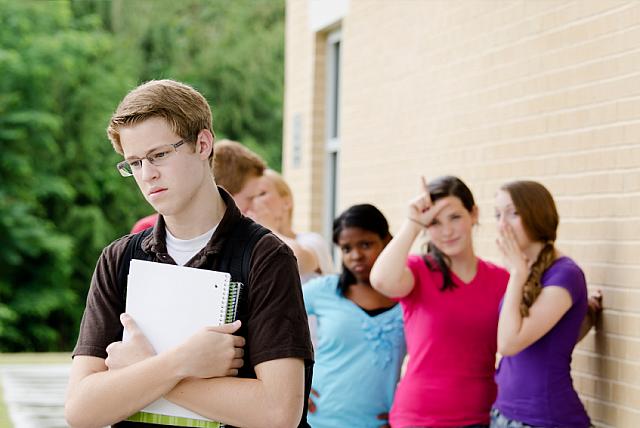By Mark Liston
 As a kid, I got beat up at home by dad and mom. I’d go to school and get beat up there too. I tried to take different routes when I walked home so the bullies wouldn’t find me. I lived in fear and didn’t like it.
As a kid, I got beat up at home by dad and mom. I’d go to school and get beat up there too. I tried to take different routes when I walked home so the bullies wouldn’t find me. I lived in fear and didn’t like it.
Now, as a dad of four kids and a professional counselor, I wanted to do something to deal with bullying. I read research that said even today teachers often ignore or don’t notice bullying. Someone told me no standard was available to answer, “What is and is not bullying? How serious is the incident?”
Consider this example: Eric tells you that Brad has been bullying him for weeks. Brad's parents are rich and known for defending their son to administration regardless of what he has done. Eric asks you to go with him to report the incident to the school office. Will the officials see this as bullying or not? Will they do anything about it?
Educators and students struggle with this question. They need a clear, authoritative definition of what is a bullying incident and how severe is it. No workable rubric has been developed, until now.
Bullying Rubric
I developed the Bullying Rubric using the federal definition of bullying. “Unwanted, aggressive behavior… that involves a real or perceived power imbalance.”

I looked at all the different types of bullying behaviors and found they all fell in four categories: Threats, Violence/Harassment, Lies/Accusation/Rumor, and Mocking/Discriminating/Excluding.
Then I figured a way to determine a severity score based on criteria such as intent, number of incidents, number of aggressors, and how public it was. I added a consequence level and suggested using character training to help the aggressor stop and the subject deal with the pain.
Some sharp educators critiqued the Bullying Rubric and suggested changes. Then they field tested it and gave it high marks. They said the rubric provides the
foundation for a district policy on bullying prevention. Its clear guidelines made administrative decisions easier and quicker while protecting students.
For Teachers and Students
The Bullying Rubric can be used by Not In Our School groups to train students to be “Upstanders” because they are sure that an aggressor has gone past teasing to bullying. Students have confidence that the administration will listen to their report because it identifies specific bullying behavior.
Many teachers like The Bullying Rubric even more than students. Its clear definitions are easily understood. They also know when to intervene with normal discipline rather than report bullying. It’s also helpful for principals and administrators. They have an objective standard by which adult staff can determine what is or is not bullying. They say it saves the district money and resources while preventing lawsuits.
The Bullying Rubric is free to download for non-profit use in schools at this link.
Permission for publication or distribution can be obtained via email. Professional development for educators is available. A sample lesson of the character training for both aggressors and subjects is at this link.
Mark Liston speaks from personal experience: Abuse at home, bullying and rejection at school, and ADD. With help from compassionate friends, Mark became a pastor and then a professional counselor in private practice, a speaker and author. C2: Character Challenge is an evidence-based program for teens used in 28 states that utilizes Positive Psychology, popular movies, and peer discussion (characterchallenge.com). Mark is a PhD candidate at the University of Missouri-St. Louis, has four children, and enjoys running, working out, and golf.
Comments
download bullying ruberic
We are putting together a community bullying workshop and would like resources to use. Please let us know how we can get this material.
Gloria Partida
The Davis Phoenix Coalition
for the prevention of hate motivated violence
Sorry so Slow
Gloria, click on the big green letters re: the rubric. It's a link to the rubric. Download the pdf to your computer and save it.
Mark
Define bullying vs stop bullying
What is a student to do when the school they attend turns a blind eye, the local authorities refuse to do anything? What does your "rubric" say about that? I graduated high school 29 years ago, entered elementury school 41 years ago and even then- we knew what bullying was, without your rubric. When we had a problem in school we told a teacher and our parents, if they didn't stop the bullying several of us would band together and take care of the problem. We didn't have school shootings back then or rampet suicide, why? We protected each other! What's changed? Parents and teachers know what bullying is, they don't need a rubric to tell them- they just refuse to get involved. Students don't band together as we did in my day so what do they do, they go on a shooting rampage or take their own life. We don't need to waste time trying to define bullying- we need to use our time and your expertise teach kids how to deal with it. I spend my time as a martial art instructor teaching kiks how to defend themselves against bullies- but only after they go to parents and teachers first. Kids have a right to defend themselves when parents and schools refuse to protect them. When we don't help them do that, they feel no other alternative than to take a life- theirs or their classmates.
But what do I know- I'm just a martial art instructor not a counselor.
Craig Cruse- chief instructor
Paducah Budo Society
Bullying Definition Clearer for Adults
Hi Mark,
Thanks for providing the bullying rubric. There definitely is more of a focus on bullying now that so many high-profile cyber-bullying stories have been in the news. Even in a professional environment, HR managers and worksafe organizations educate employees on what bullying is and how to report it. There is no doubt that kids face these challenges and need more help from us adults.
Add new comment